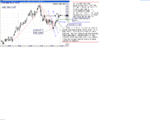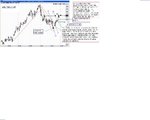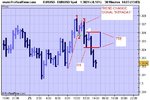Pratbh
Regarding your question concerning 123 & the RH with the examples you have displayed.
First I do not follow the RH specifically but I do trade from price alone so our methods are very similar. As with all trading methods they do not work all of the time so you have to be ready for this.
When trading you have to have a complete trading plan and with that comes the confidence to know what you are doing and your intent at any time. From your chart example there is insufficient data. Are we dealing with an intraday position or something from the daily. On the basis of the price bars you plot then it would depend what the overriding trend was for the time-frame you display. Therefore if the trend is down you look for a secondary failing to enter a sell or a break of the trend itself according to your style. But on this thread applying the TTE approach then you would look to sell before the relevant point. If it was an uptrend then you would be looking to buy in a similar fashion.
So the answer to your question really is you need to define what the trend is at that time and focus on that and apply your trading method to it. If the position does not meet your requirements then you stand aside and wait for a better or clearer opportunity. The method is everything.
Regarding your question concerning 123 & the RH with the examples you have displayed.
First I do not follow the RH specifically but I do trade from price alone so our methods are very similar. As with all trading methods they do not work all of the time so you have to be ready for this.
When trading you have to have a complete trading plan and with that comes the confidence to know what you are doing and your intent at any time. From your chart example there is insufficient data. Are we dealing with an intraday position or something from the daily. On the basis of the price bars you plot then it would depend what the overriding trend was for the time-frame you display. Therefore if the trend is down you look for a secondary failing to enter a sell or a break of the trend itself according to your style. But on this thread applying the TTE approach then you would look to sell before the relevant point. If it was an uptrend then you would be looking to buy in a similar fashion.
So the answer to your question really is you need to define what the trend is at that time and focus on that and apply your trading method to it. If the position does not meet your requirements then you stand aside and wait for a better or clearer opportunity. The method is everything.









